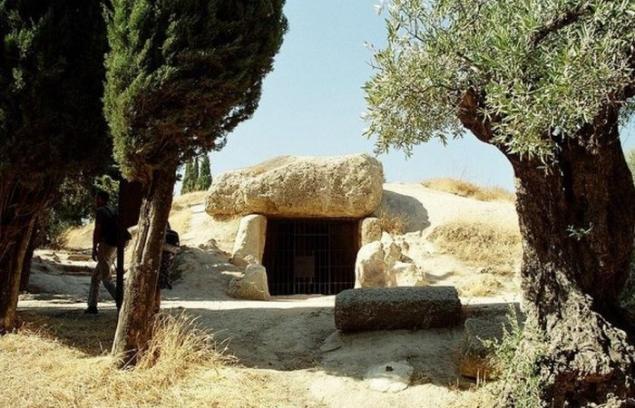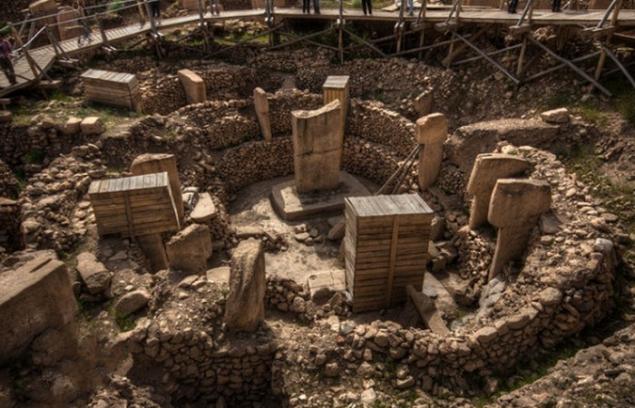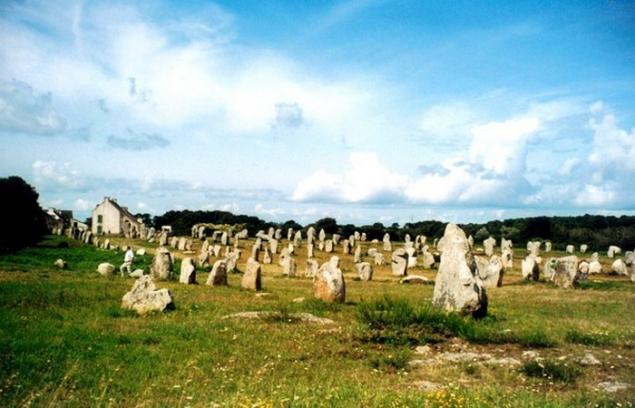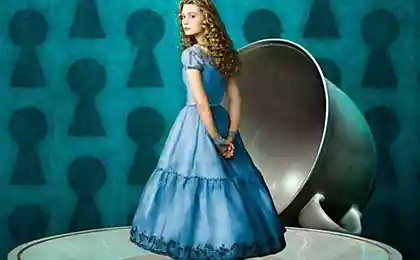1224
10 ancient wonders that still remain a mystery
Throughout human history, civilizations were born and died countless times. Today, anthropologists and archaeologists trying to piece together the chronology of the rise and fall of civilizations. This often discovers a secret that is not possible to solve. < Website published an interesting selection devoted to such archaeological mysteries.
1. Unfinished Obelisk In Egypt, the northern part of the quarries of ancient Egypt in Aswan has been found so-called "Unfinished Obelisk", which is more than any of the obelisk, which was built in the history of mankind. Its height (or rather, the length, because the obelisk is) is 42 meters. Some scientists believe that its construction was abandoned, as revealed in the process of building cracks. Others believe that the Pharaoh Hatshepsut has banned the construction of the obelisk. If it has been completed, the height of the building would be about 42 m, and it would weigh about 1,200 tons.

2. Dwarka. The mythical city in IndiiDvarka is one of the oldest cities in India. Now this city of 8 km × 3 rests on the 35-meter depth in the Gulf of Cambay off the western coast of India. The discovery was particularly surprising to scientists because Dwarka over all other discoveries in this area, at least 5000 years, which indicates a much longer history of civilization than previously thought (carbon dating estimates the age of Dwarka in 10,000 years). It is believed that the city was flooded at the time of the last ice age, when they began to melt Arctic ice. Surprisingly, many of the architectural elements have remained untouched.

3. Menga dolmen in Menga IspaniiDolmen (or Dolmen of Menga) - megalithic burial mound dating back to the 3rd millennium BC. It is located near the town of Antequera in the Spanish province of Malaga. Built dolmen of the 32 blocks of stone, which comes to the weight of 180 tons. When this ancient tomb was opened and examined in the 19th century, archaeologists found the skeletons of several hundred people inside.

4. Ggantija on MalteMegalitichesky temple complex on the island of Gozo, which is older than Stonehenge and the Pyramids, is one of the most important archaeological sites in Malta. It consists of a complex of two giant temples, built in the Neolithic period (about 3600 - 2500 GG BC..), Which are surrounded by a common wall, built from standing stones of up to 5, 5 m and weighing up to 50 tons. It is believed that Ggantija was built for the celebration of fertility, since it images and statuettes associated with fertility were found. Due to the gigantic megaliths in past centuries some locals believed that the temples were built by giants.

5. Yonaguni Monument in YaponiiYonaguni - flooded huge megalithic complex off the coast of Yonaguni, the southernmost of the Ryukyu islands in Japan. In 1986, a diver Kihachiro Arataki near Yonaguni noticed a strange structure at a depth of about 25 meters. His stunned huge rectangular formation (with the ideal angle of 90 degrees), straight walls, stairs, columns and stepped pyramids. In the center stood a complex of 5-storey building height of 42, 43 meters and 183 Parties to 150 m. A huge stone monument consisted of a perfectly smooth flat platforms and terraces of unusual shapes.

It was also found other interesting objects, including sculptures made of stone, which resemble the shape of animals. Masaaki Kimura, a marine geologist at Ryukyu University in Japan, who has studied this place for more than 15 years, believes that the age of the Yonaguni is about five thousand years, and he was sunk during an earthquake two thousand years ago. Others have estimated that the structure is much older. Later, along the coast of Yonaguni dozens of other structures have been found, including lock, five temples, and something like a huge stadium. All these structures are connected to each other by roads and canals.
6. Olmec heads in MeksikeOlmeki were developed early Mesoamerican civilization, which had a great influence on later cultures such as the Aztecs and Mayans. Olmec culture flourished off the coast of modern-day Mexico from 200 to 400 BC. e. The Olmecs were extremely talented artists and sculptors, after this civilization left many statues, steles, masks, statues, and so on. D.

The most famous creation is Olmec giant stone heads - at least seventeen monumental stone sculptures of human heads, which are carved out of large basalt boulders. Age of stone heads dated to at least 900 BC. e. Now there is a lot of controversy in the scientific community as to the origin of sculptures given explicitly African features of their faces.
7. Gobekli Tepe in TurtsiiHramovy complex in the Armenian Highland - the oldest of the large megalithic structures in the world. Its age is estimated at a staggering 12,000 years, t. E. Gobekli Tepe ancient Stonehenge by 6,000 years. It represents the complex series of round and oval structures of stone, built on top of a hill. Although Gobekli Tepe first found in 1963, with further excavations in 1995 it became clear that the complex is not only one, but from a variety of churches and other religious buildings of the Stone Age.

8. Carnac stones FrantsiiKarnakskie stones - a huge and very tight group standing megaliths (consisting of more than 3,000 menhirs, dolmens and burial mounds) in the territory of the French commune of Carnac. Carnac megaliths arranged in long rows of hundreds of structures, some of which extend in length to more than a kilometer. Researchers believe that the construction of megaliths in Carnac started somewhere in the Neolithic period (about 4000 BC. E.), And they were built for the next 2,000 years.

There are three main groups of stone rows: Le Menek, Kermario and Kerlescan
.
Le Menek - Eleven converging rows of menhirs, along the length of 1165 meters and 100 meters wide
.
Kermario - 10 divergent fan series, consisting of 1029 stone columns, about 1,300 meters in length
.
Kerlescan - a small group of 555 stones, which lies to the east of the other two compositions. It consists of 13 rows of stones with a total length of about 800 meters.
9. Giant stone balls in Costa RikeKamennye balls are one of the strangest mysteries in archeology, found at the mouth of the river Dikvis, on the Nicoya Peninsula and Cano Island in Costa Rica. Since 1930, we have already found hundreds of these stone balls in diameter from a few centimeters to over 2 meters. Today there are about 300 balls, the largest of which weigh more than 16 tons. Almost all the balls are made of granodiorite in (scientists believe) 1000 - 500 GG BC. e. Origin of stones surrounded by many myths. One of them says that the balls were from Atlantis. For what they were used, no one knows.

10. Moai of Easter Island PaskhiOstrov, which is a territory of Chile, is located in the southeastern part of the Pacific Ocean. The most famous Easter Island its 887 gigantic monolithic statues "moai", which were carved by the local population between 1250 and 1500 BC. e. The height of the large statue - 21 meters, and it weighs more than 160 tons. The average height of the statues - 4 meters. There has been much speculation about the intended article and the role they play for the ancient civilization of Easter Island moai but still remain a mystery.

via www.novate.ru/blogs/140116/34561/
1. Unfinished Obelisk In Egypt, the northern part of the quarries of ancient Egypt in Aswan has been found so-called "Unfinished Obelisk", which is more than any of the obelisk, which was built in the history of mankind. Its height (or rather, the length, because the obelisk is) is 42 meters. Some scientists believe that its construction was abandoned, as revealed in the process of building cracks. Others believe that the Pharaoh Hatshepsut has banned the construction of the obelisk. If it has been completed, the height of the building would be about 42 m, and it would weigh about 1,200 tons.

2. Dwarka. The mythical city in IndiiDvarka is one of the oldest cities in India. Now this city of 8 km × 3 rests on the 35-meter depth in the Gulf of Cambay off the western coast of India. The discovery was particularly surprising to scientists because Dwarka over all other discoveries in this area, at least 5000 years, which indicates a much longer history of civilization than previously thought (carbon dating estimates the age of Dwarka in 10,000 years). It is believed that the city was flooded at the time of the last ice age, when they began to melt Arctic ice. Surprisingly, many of the architectural elements have remained untouched.

3. Menga dolmen in Menga IspaniiDolmen (or Dolmen of Menga) - megalithic burial mound dating back to the 3rd millennium BC. It is located near the town of Antequera in the Spanish province of Malaga. Built dolmen of the 32 blocks of stone, which comes to the weight of 180 tons. When this ancient tomb was opened and examined in the 19th century, archaeologists found the skeletons of several hundred people inside.

4. Ggantija on MalteMegalitichesky temple complex on the island of Gozo, which is older than Stonehenge and the Pyramids, is one of the most important archaeological sites in Malta. It consists of a complex of two giant temples, built in the Neolithic period (about 3600 - 2500 GG BC..), Which are surrounded by a common wall, built from standing stones of up to 5, 5 m and weighing up to 50 tons. It is believed that Ggantija was built for the celebration of fertility, since it images and statuettes associated with fertility were found. Due to the gigantic megaliths in past centuries some locals believed that the temples were built by giants.

5. Yonaguni Monument in YaponiiYonaguni - flooded huge megalithic complex off the coast of Yonaguni, the southernmost of the Ryukyu islands in Japan. In 1986, a diver Kihachiro Arataki near Yonaguni noticed a strange structure at a depth of about 25 meters. His stunned huge rectangular formation (with the ideal angle of 90 degrees), straight walls, stairs, columns and stepped pyramids. In the center stood a complex of 5-storey building height of 42, 43 meters and 183 Parties to 150 m. A huge stone monument consisted of a perfectly smooth flat platforms and terraces of unusual shapes.

It was also found other interesting objects, including sculptures made of stone, which resemble the shape of animals. Masaaki Kimura, a marine geologist at Ryukyu University in Japan, who has studied this place for more than 15 years, believes that the age of the Yonaguni is about five thousand years, and he was sunk during an earthquake two thousand years ago. Others have estimated that the structure is much older. Later, along the coast of Yonaguni dozens of other structures have been found, including lock, five temples, and something like a huge stadium. All these structures are connected to each other by roads and canals.
6. Olmec heads in MeksikeOlmeki were developed early Mesoamerican civilization, which had a great influence on later cultures such as the Aztecs and Mayans. Olmec culture flourished off the coast of modern-day Mexico from 200 to 400 BC. e. The Olmecs were extremely talented artists and sculptors, after this civilization left many statues, steles, masks, statues, and so on. D.

The most famous creation is Olmec giant stone heads - at least seventeen monumental stone sculptures of human heads, which are carved out of large basalt boulders. Age of stone heads dated to at least 900 BC. e. Now there is a lot of controversy in the scientific community as to the origin of sculptures given explicitly African features of their faces.
7. Gobekli Tepe in TurtsiiHramovy complex in the Armenian Highland - the oldest of the large megalithic structures in the world. Its age is estimated at a staggering 12,000 years, t. E. Gobekli Tepe ancient Stonehenge by 6,000 years. It represents the complex series of round and oval structures of stone, built on top of a hill. Although Gobekli Tepe first found in 1963, with further excavations in 1995 it became clear that the complex is not only one, but from a variety of churches and other religious buildings of the Stone Age.

8. Carnac stones FrantsiiKarnakskie stones - a huge and very tight group standing megaliths (consisting of more than 3,000 menhirs, dolmens and burial mounds) in the territory of the French commune of Carnac. Carnac megaliths arranged in long rows of hundreds of structures, some of which extend in length to more than a kilometer. Researchers believe that the construction of megaliths in Carnac started somewhere in the Neolithic period (about 4000 BC. E.), And they were built for the next 2,000 years.

There are three main groups of stone rows: Le Menek, Kermario and Kerlescan
.

Le Menek - Eleven converging rows of menhirs, along the length of 1165 meters and 100 meters wide
.

Kermario - 10 divergent fan series, consisting of 1029 stone columns, about 1,300 meters in length
.

Kerlescan - a small group of 555 stones, which lies to the east of the other two compositions. It consists of 13 rows of stones with a total length of about 800 meters.
9. Giant stone balls in Costa RikeKamennye balls are one of the strangest mysteries in archeology, found at the mouth of the river Dikvis, on the Nicoya Peninsula and Cano Island in Costa Rica. Since 1930, we have already found hundreds of these stone balls in diameter from a few centimeters to over 2 meters. Today there are about 300 balls, the largest of which weigh more than 16 tons. Almost all the balls are made of granodiorite in (scientists believe) 1000 - 500 GG BC. e. Origin of stones surrounded by many myths. One of them says that the balls were from Atlantis. For what they were used, no one knows.

10. Moai of Easter Island PaskhiOstrov, which is a territory of Chile, is located in the southeastern part of the Pacific Ocean. The most famous Easter Island its 887 gigantic monolithic statues "moai", which were carved by the local population between 1250 and 1500 BC. e. The height of the large statue - 21 meters, and it weighs more than 160 tons. The average height of the statues - 4 meters. There has been much speculation about the intended article and the role they play for the ancient civilization of Easter Island moai but still remain a mystery.

via www.novate.ru/blogs/140116/34561/
12 habits of people who at home is always clean
Never take your eye from the cashier when paying card!























